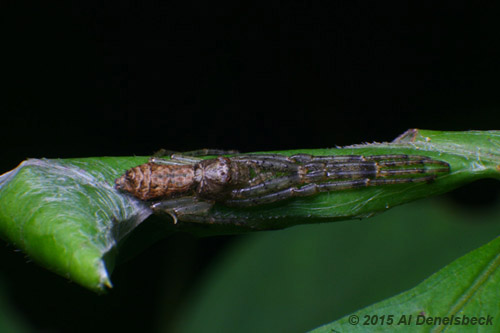Canon 30D, handheld
Sigma 28-105 reversed at 28mm, fixed f16
Sunpak FP38 flat-panel flash w/ softbox
1/200 second at ISO 250
Canon 30D, handheld |
| Too close | |
 |
|
As ugly as this spider is, I'm delighted with how it came out.
First off, the technique. The spider actually measured just 1mm between the largest eyes, so 5 or 6mm in body length (not counting legs) – in other words, pretty insignificant. I noticed its camouflaging behavior (illustrated below) and went in for the extreme closeup, in this case with a somewhat esoteric macro trick. My old Sigma 28-105 had died years ago, and for giggles one day I decided to try it out reversed, putting the front of the lens against the body and shooting through it backwards, which is a trick that can be done with wide-angle lenses. It worked so well that I disassembled it, pulled out the tiny motor that operated the aperture blades, and manually set the aperture for roughly f16 where it remains. This makes the viewfinder image very dark, since cameras normally do not actually close down the aperture until after you trip the shutter. To be able to even focus on a subject, I need to use a strong LED light aimed right at the focal point.
Focus is, shall we say, precise – as can be determined from the photo, the range of sharpness is extremely short even at f16, and it's very easy to be slightly off from where I might want to be. Breathing can affect focus, much less the typical very slight swaying us bipedal critters can suffer from, and though I was braced against a nearby fence, pinning down exact focus was still tricky. Yes, I have frames that did not pass muster – I never shoot just one frame of something like this, but aim for as much security as I think I might need.
The spider itself is interesting. This is a crab spider species, almost certainly a Tmarus angulatus, but its eyes help us from being not completely creeped out (I'm speaking on average here, and cannot vouch for what any individual feels when looking at this.) Many spiders, including most crab spider species, have just tiny little beads of eyes, arranged in many different ways, but this one has two of them large enough and facing forward enough for us to recognize it as a face, more or less, easily ignoring the other eyes. But the shape, texture, and coloration of the spider all came out very well under these lighting conditions, and that all adds to the portrait.
 This shows what I first saw – actually, I saw the rolled-up leaf (probably housing the spider's eggs) and then realized there was a grey line atop that wasn't typical. From end of abdomen to tip of forelegs, the spider measures 15mm, so less than the width of your forefinger – you could kill it with a sneeze. So, yeah, I'm pleased with a portrait that looks like the above.
This shows what I first saw – actually, I saw the rolled-up leaf (probably housing the spider's eggs) and then realized there was a grey line atop that wasn't typical. From end of abdomen to tip of forelegs, the spider measures 15mm, so less than the width of your forefinger – you could kill it with a sneeze. So, yeah, I'm pleased with a portrait that looks like the above.
